Have you ever fought a battle where you seemed to have a bigger fleet, but your friend somehow managed to come out on top and now you are losing the game? That’s probably because he read this guide before you did. 😉
In this guide we will talk about basic combat mechanics, ship counters, changes in Sins II and much more!
Understanding Defense Stats
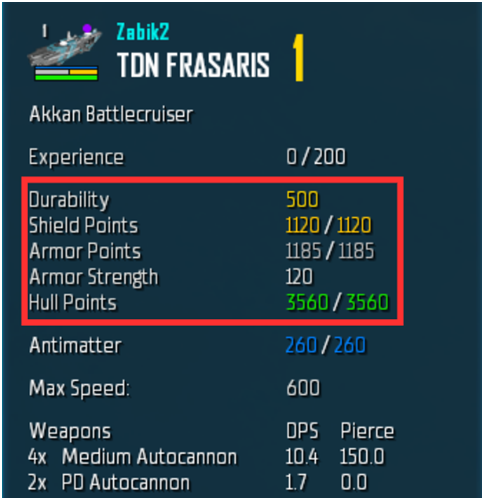
Note: Different factions excel at different defense stats. Vasari will have better hull with decent armor and shields, Advent will have best shields with decent hull and low armor, while TEC will have best armor with decent hull and weak shields. Furthermore TEC are so far behind in shield technology, that their frigates require a separate technology, to even have them.
Damage Reduction
Durability is akin to “shield mitigation” from Sins: Rebellion: It does not increase with the incoming damage, but is rather a flat value. The further benefit of this change is that people will no longer assume that “shield mitigation” only applies to shields, which was wrong for Sins: Rebellion. This means durability applies to ALL hit points (shields, armor, hull points, crippled hull). Durability is countered by the “Pierce” value of a weapon. The exact formula will be shown in a following chapter.
Armor Strength is another damage reduction attribute, which works only on Armor hit points. It is NOT countered by the Pierce value of enemy weapons, which provides a much more reliable source of damage reduction. The formula of the damage reduction for armor strength is very similar to that of durability.
Hit Point Attributes
Advent having the strongest shields, also have access to a unique technology “Shield Burst”, which is triggered some time after a ship’s shields are depleted. Basically, it’s a recharge of shield hit points after a timer. The timer depends on ship, but will usually be between 40-80 seconds – meaning your ship can get a spontaneous extra pool of health, should it survive a bit longer in combat. Enemies do see the timer of the shield burst, so a skilled player will try to focus fire a ship, before it is able to recharge its shields.
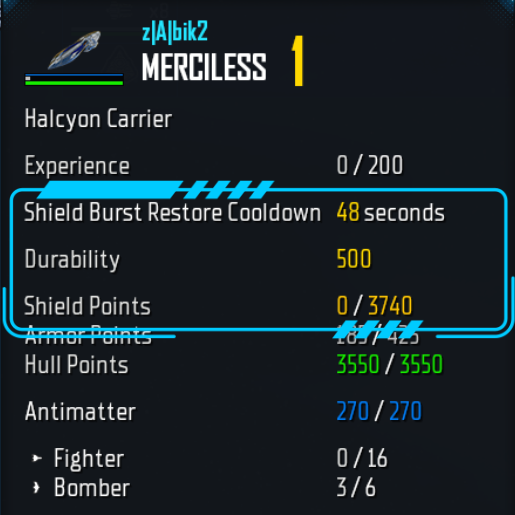
Vasari Exodus do not get shield burst, but they do get an in combat shield regeneration technology, which fits very well into their other regeneration upgrades.
Meanwhile Vasari Alliance can get shield burst, as one of their unique technologies, which however will be weaker, when compared to Advent capabilities.
Armor is your next line of defense once shields are down. This is also the most effective type of hit points, as Armor combines damage reduction from Durability and Armor Strength. The benefit from Armor Strength is actually multiplicative with Durability, so this is really a tough spot on a ship.
Hull will be the last hit points pool for smaller ships. Armor Strength no longer applies, so frigates and cruisers who are down to hull will likely not see the next day. Capital ships (and titans) are another story. Those gigantic ships have an extra mechanic: Once Hull reaches 0 they get a new health bar called “Crippled Hull” which allows them to live a bit longer.
Crippled Hull is really the final hit points for your most elite units. It can often save lives of those valuable ships, as you get that extra life. However, if a ship enters a crippled state, it will not be able to use any abilities, weapons or components. You have to repair your ship above a certain threshold before it becomes functional. Crippled Hull is hidden from the UI until your capital ship has lost all other hull points, such as in the screenshot below:
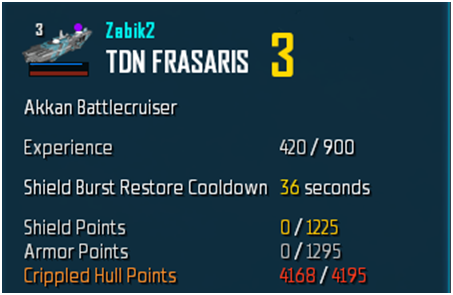
Finally, repairing is not a raw stat, but it contributes to the life of your ship. Each ship has individual passive repair stats; those are disabled during combat (with the exception of Vasari). Therefore, they do not contribute to survivability in a single battle but help a lot if you deal with waves of attacks. You can access those values either by pressing Alt, while hovering your mouse over your ship, or checking the defenses as shown in the picture:

Understanding Offense Stats

Each weapon has 4 stats shown in game: quantity, type (e.g., autocannon, gauss, missiles), DPS and Pierce.
The weapon type, unless it’s missiles, is relevant for buffs only. Buffs can come from abilities, components or technologies. Technologies mostly buff only a specific weapon type – like this T1 technology for autocannons:
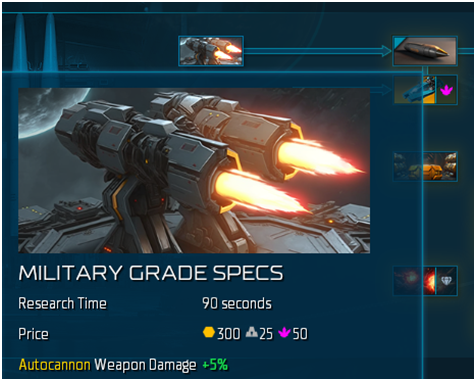
The second stat is DPS. This is a straightforward value of damage a weapon deals per second (before damage reduction comes into play).
NOTE: DPS shown on the card is for 1 weapon only. In the case of the Kol we have 2 gauss cannons, each dealing 17.3 DPS. Meaning the DPS of all gauss cannons is 34.6; and the DPS of the entire ship is 99.3 at level 1.
Pierce is a counter value to Durability. Having more Pierce than the enemy has Durability provides no benefit. Usually, you want to match ships with high Pierce against high Durability units (such as capital ships) and throw your low Pierce ships against low Durability ships (such as corvettes).
The base Durability value for capital ships is 500. Gauss cannons on the Kol have a Pierce of 600, making the Kol a capital ship killer.
Pro tip: Damage buffs do NOT stack multiplicatively. All of the buffs are applied to the base stat. E.g. having +10% Gauss damage from research and +25% from a module, will only give a sum of +35% damage increase.
Missiles Inbound!
Missiles deserve their own tiny chapter, as Sins 2 introduces a major change to how they function. Each missile is a “unit” with a health bar, which can be shot down by flak weapons or abilities. TEC and Vasari missiles have high Pierce value, making them perfect capital ship slayers, and their DPS is one of the highest in the game. So surprising your enemy with a few missile cruisers can mean a quick end to his capital ship, unless he brings enough flak defenses. Meanwhile, Vasari do get even deadlier missiles, as those can bypass shields.
Some capital ships have flak weapons installed on them; the Sova Carrier is probably the best capital ship in this matter as it houses 9 point defense cannons which are able to shut down fire from several Javelis frigates.
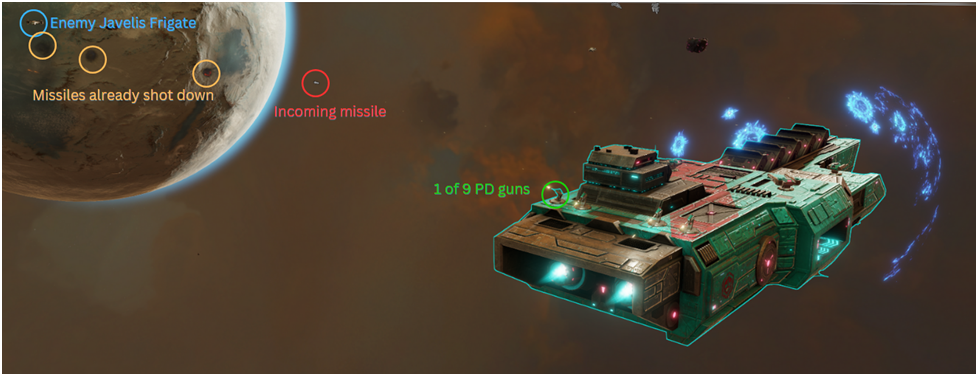
he Sova Carrier can easily shoot down all missiles from a single Javelis frigate. But once it faces multiple Javelis, missiles get dangerously close even through its specialized defenses:
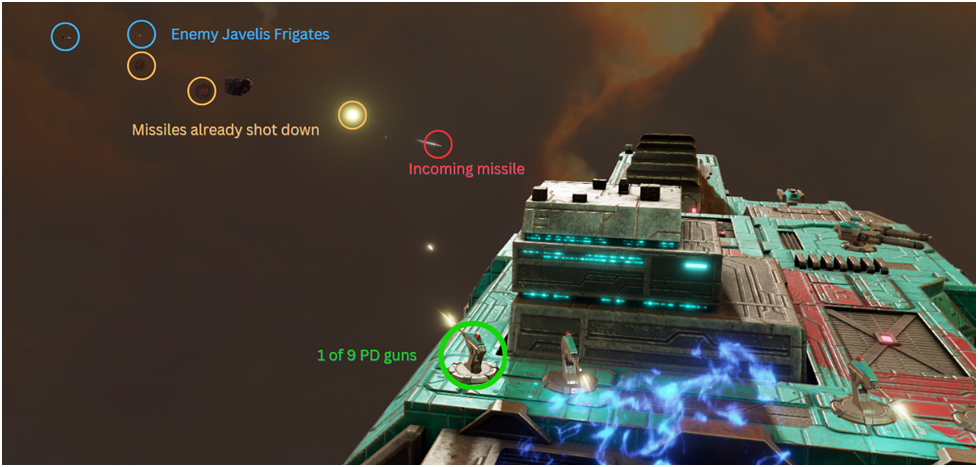
As you can note on the screenshot, many PD guns are not facing the incoming missile. This is not because they are shooting down missiles from the other direction, but because they cannot fire through the “bridge” of the ship. There are 4 PD guns at the rear, but only one of them is currently firing. If we were to face our rear towards the Javelis frigates, the bridge would be no longer in the way and 8 of 9 PD guns would be able to provide protection.
Note: Advent also make use of missiles, however those are “light missiles” with no pierce at all, but much higher damage. This makes advent missiles deadly to corvettes and frigates, but rather ineffective against capital ships.
Ship Firing Arcs
This makes knowing your firing arcs important. You will get a feeling for it simply by observing your ships, but we will give a few examples here.
As we mentioned, the Kol has 2 gauss cannons. Both are marked in the screenshot below:
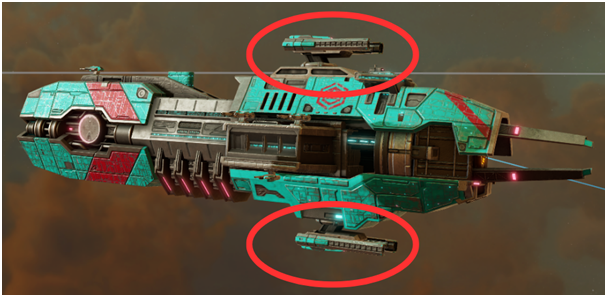
These are your giant slayer cannons with 600 Pierce, so being able to fire from them (or avoid their fire) is very important.
Due to their positions above and below the main hull, both cannons can rotate 360°, so flying in circles around the Kol will not help you avoid its vengeance.
However, those guns still have blind spots, as ships do move in a 3D plane, and could end up bellow or above a Kol, which would render one of the Gauss cannons silent, as it will not be able to rotate and fire through the ship. That’s -50% DPS from gauss cannons, which are the real damage dealers.
Another example with Kol weaponry is on the left side where you have 2 of its medium autocannons.
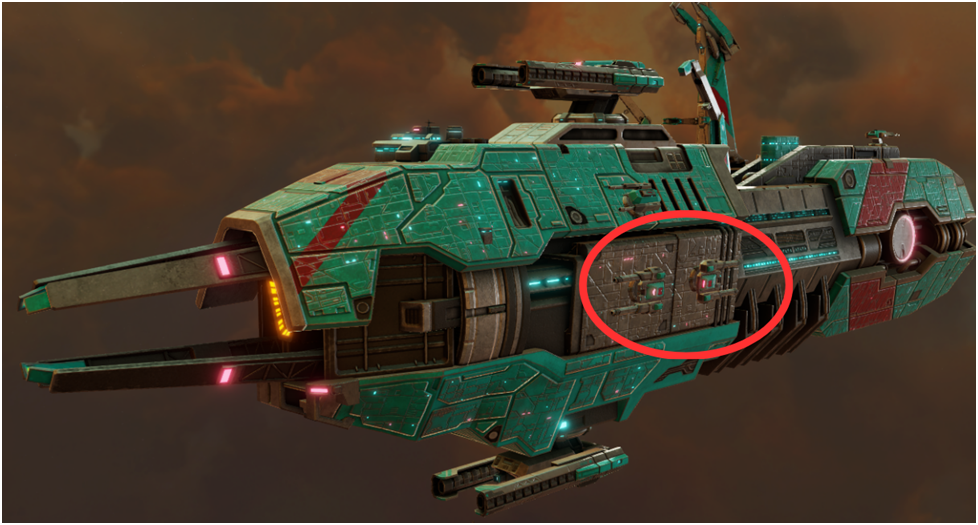
They do rotate, but only in a 180° arc. Therefore, if you do want to maximize your damage against smaller ships, you should place your Kol not in front but in the middle of the enemy formation.
There are also fixed mount weapons. If you were to look at a Cobalt, you would notice, that its cannons are in fact mounted to the ship:
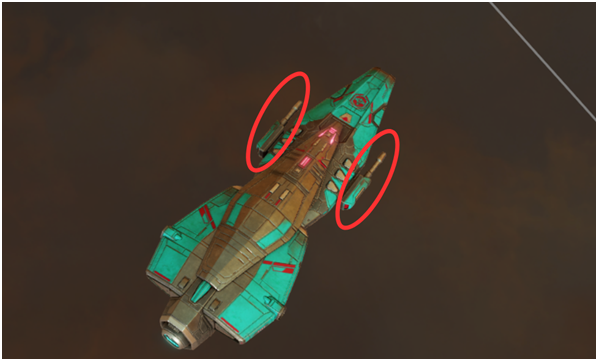
This means Cobalts have a very limited fire arc in front of them; and it’s not 90° as it would have been in Sins: Rebellion. The actual value is closer to 15°. So even flanking Cobalts makes a huge difference, as they will not be able to fire back.
Ship Counters
NOTE: Unlike Sins: Rebellion, there are no “hidden” damage multipliers. A light frigate counters flak not because it gets a hidden buff, but because the in-game stats are fine tuned to allow him excel in this role.
Light frigates are a semi-counter to corvettes – if they can catch them of course. But if facing Vasari, you should specialize your fleet and build flak frigates which counter corvettes.
NOTE: Long range frigates for Vasari and TEC are a hard counter to capital ships, and not light frigates, as it was in Sins:Rebellion. Therefore even 1 Javelis frigate will deal massive damage to your capital ship, should it lack PD guns.
Carriers allow you to fight from afar, and heavy cruisers are the ultimate non-capital ship class.
NOTE: Unlike Sins: Rebellion, anti-structure cruisers can attack other targets, and actually are decent at killing high value targets, such as capital ships and titans.
Finally, support cruisers are countered by everything, but their role there is to support your fleet, so that’s where they excel.
Fleet Annihilation Danger
These are AOE abilities. Some AOE abilities will require several shots (like from the Ragnarov titan); some will actually be a “fire and forget” (like the Marza’s missile barrage). Not knowing, and more importantly, not countering those abilities will often lead to the loss of an entire fleet.
This is why you should watch out for the following ships:
Ships listed here are not meant to be “the only ships you build.” Sins II is all about finding a counter to your opponent. And while those ships are dangerous, this statement is true only if you try to “auto battle” them. In truth, there are plenty of disable and support capital ships who can counter this danger.
To come out on top of your opponent, you will have to make use of both the AOE damage dealers and their counters.
Damage Reduction Formula
Durability affects all 4 kinds of hit points and is calculated BEFORE Armor Strength.
IMPORTANT: Having more Pierce than Durability does not increase damage.
First of all, you need to subtract Pierce from Durability. So, if a capital ship has 500 Durability, and a Javelis has 400 Pierce, that’s 500-400 = 100 (effective Durability).
Damage dealt to a ship is calculated as 100/(100 + effective Durability) in %. For our example that’s 100/(100+100) = 50%. Meaning a Javelis frigate deals 50% of its original damage to a capital ship.
A flak frigate with 0 Pierce would deal mere: 100/(100+500) = 16.7% of its original DPS.
In other terms, when comparing DPS between ships keep in mind that a Javelis frigate has 3x more effective DPS than a Garda against capital ships.
Here is a graph of effective damage %, depending on effective Durability:

Armor Strength uses the same formula, applied to effective damage AFTER it was reduced by effective Durability. This means a multiplicative stacking between those 2 parameters. Keep in mind that this one applies to Armor hit points only.
It would require a 3D graph and a PhD to understand the graph, so we will simply look at a few examples in a table:
More Guides:
- Sins of a Solar Empire II: Vasari Alliance Multiplayer Quick Guide
- Sins of a Solar Empire II: Capital Ships Module Guide
- Sins of a Solar Empire II: Planet Modules Guide
- Sins of a Solar Empire II: Economy Guide
- Sins of a Solar Empire II: How to Skip the Launcher
